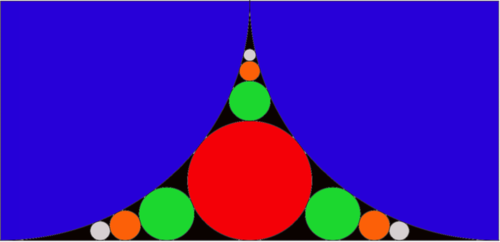Revival of Sangaku
 The radius of the blue circular quadrants is one. If the above pattern continues
ad infinitum
, express the area of the nested circles as an infinite sum. Once that is done, calculate the total area of the nested circles.
The radius of the blue circular quadrants is one. If the above pattern continues
ad infinitum
, express the area of the nested circles as an infinite sum. Once that is done, calculate the total area of the nested circles.
Notes:
1) As illustrated above, the pattern expands in three directions only (up - up, left - left, right - right)
2) The nested circles do not include the two blue quadrants
The answer is 0.352.
This section requires Javascript.
You are seeing this because something didn't load right. We suggest you, (a) try
refreshing the page, (b) enabling javascript if it is disabled on your browser and,
finally, (c)
loading the
non-javascript version of this page
. We're sorry about the hassle.
2 solutions
I solved this question because it said lvl 4 and I had never solved a lvl 5 question before. Today, it suddenly jumped to lvl 5...
Steven, how did you know the sequence the top and symmetric circles would follow?
Log in to reply
You may use Descartes' Circle Theorem as well.
( k 1 + k 2 + k 3 + k 4 ) 2 = 2 ( k 1 2 + k 2 2 + k 3 2 + k 4 2 )
Plugging in k 1 = k 2 = 1 , k 3 = 4 , we get k 4 = 1 2 .
Radius of 3rd circle(upwards)= 1 2 1
Seems easier than applying the Pythagorean Theorem a bunch of times :)
By applying the Pythagoras theorem many times. It is not too hard, and yes, my trick will lead to a series. I was lucky enough to discover that this problem requires only the zeta function and telescoping series only. Which meant I can actually find the closed form solution.
Log in to reply
Can you point out where exactly you used the pythagorean theorem over and over?
Why are the radii of the upward circles 2 n ( n − 1 ) 1 ? I believe it is 2 n ( n + 1 ) 1 , since the radii of the first green upward circle is 1 2 1
Log in to reply
Sorry. Typo
Log in to reply
Actually I said starting n=3, which is the same thing.
Nice problem. I got tripped up because I assumed the upward nested circles were the same size as the right and left nested circles because of the coloring pattern. Stupid mistake considering I knew the zeta function came into play :(
I didn't know how the radii of a circle in this situation compared to the ones before it in a sequence, so I had to solve this problem a bit different than Steven Zheng described.
I first used the geometry of the problem to generate a set of recursive functions:
For the top circles, define c i = 1 − 2 Σ j = 1 i − 1 r j r i = 2 ( 1 + c i ) c i 2 c 0 = 1 r 0 = 4 1
For the symmetric circles, define x i = x i − 1 ( 1 − r i − 1 1 − r i − 1 ) r i = 4 x i 2 x 0 = 1 r 0 = 4 1
Note that x i is the horizontal distance between the closet edge and circle i . One can then use these recursive equations to obtain each r i for the top and symmetric circles. The final equation for the area of the circles is then:
A t o t a l = A 0 + Σ i = 1 ∞ ( A i t + 2 A i s ) A t o t a l = π ( r 0 2 + Σ i = 1 , t ∞ r i 2 + 2 Σ i = 1 , s ∞ r i 2 )
Where t denotes the top circle series and s denotes the symmetric circles series.
One is then able to just compute the series using some programming language until you see no change in the value of A t o t a l , as you will have hit the limits of finite precision.
Cheers.
You have to be careful with the geometry and algebra of this problem! The largest circle (red) has a radius of 4 1 .
The radii of the upward circles follow the sequence 2 n ( n − 1 ) 1 starting from n = 3 . Let us call this Class 1.
The radii of the side circles are symmetric at both sides, which follow the sequence n 2 1 , once again starting at n = 3 . Let us call this Class 2.
Therefore, the total area is (Class 1) + 2(Class 2), which under close inspection exploits the zeta function and telescoping series. The subsequent answer is 3 6 0 8 π 5 + 3 0 π 3 − 1 0 3 5 π .